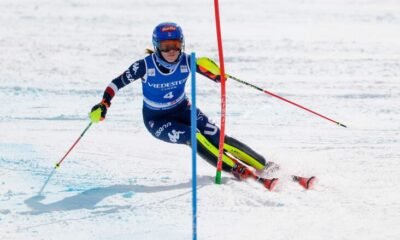Blog
Mikaela Shiffrin’s Current Health Status as She Prepares For The 2026 Winter Olympics in Milan-Cortina, Can She Still Perform at Her Best?
Mikaela Shiffrin’s Health in Focus: A Deep Dive Before Milan-Cortina 2026
A Career Interrupted: The Crash That Changed Everything
As Mikaela Shiffrin intensifies her preparations for the 2026 Winter Olympics in Milan-Cortina, one of the primary storylines isn’t merely her ambition or past glory, but her current health. In late November 2024, Shiffrin suffered a dramatic crash during the Giant Slalom in Killington, Vermont, one that led to a deep abdominal puncture wound and significant trauma to her oblique muscles. The injury was serious: doctors had to perform surgical work to clean and drain an internal cavity that could not be managed via simpler methods, and Shiffrin later revealed she underwent an unexpected follow-up procedure to clear residual old hematomas.
Importantly, no bones were broken, no ligaments torn, and no major organs punctured—according to official statements. Still, the injury’s location and severity carry profound implications: the core and oblique musculature play critical roles in skiing, balance, rotation, and absorbing shock. Rehab would have to be cautious, strategic, and patient.
Recovery Timeline: Progress, Setbacks, and Uncertainty
After her fall, Shiffrin was sidelined from competition for about two months. She only returned to the slopes in January 2025, racing in Courchevel and finishing 10th in the slalom. That comeback wasn’t seamless: she later revealed that her recovery had complications, including a small internal cavity that needed to be addressed surgically because it was not draining sufficiently on its own.
At one point, Shiffrin’s return to the World Cup circuit was described as “uncertain,” as she navigated not only the physical healing but factors like pain management, mobility, and maintaining strength without risking relapse. The Juventus of skiing faced a precarious balance: trying to regain momentum while guarding against overexertion.
Yet despite those challenges, she defied many expectations. She went on to claim two notable slalom victories during the 2024–25 season, including one at the World Cup Finals in Sun Valley, taking her total wins beyond 100. Her performance was a statement: though interrupted, her competitive edge remained.
Pain, Healing, and the Fading Ache
One central question: does the injury still hurt? By early 2025, Shiffrin stated that her abdominal area no longer felt painful, crediting the natural healing process of muscles that gradually mend over time. She confirmed that lingering pain was no longer a limiting factor—a crucial development given the demands of elite alpine skiing. That said, healed tissue is often more vulnerable; residual weakness, scar tissue, or “memory” of trauma can challenge full recovery.
To support her return, Shiffrin has incorporated highly controlled rehabilitation and conditioning protocols. Focus has shifted from sheer volume to thoughtful, deliberate training—emphasizing stabilization, core integrity, controlled movement, and progressive loading.
The Mental Toll: PTSD and Psychological Recovery
Physical pain was not the only challenge Shiffrin faced. In the months following the Killington crash, she shared that she was diagnosed with post-traumatic stress disorder (PTSD). She revealed that the crash triggered recurrent distressing visions, mental strain, and difficulty compartmentalizing trauma. At one point, she even opted out of defending her title in the World Championships Giant Slalom because she felt she wasn’t mentally ready.
Shiffrin has said that therapy, open dialogue, support from her team and loved ones, and repeatedly returning to the start gate were key in her psychological recovery. This dual process—healing body and mind—is among the most delicate aspects of elite sport. She has spoken candidly about vulnerability being part of the process rather than a weakness.
Current Status: Not Fully “Normal,” but Resilient
As of late 2025, Shiffrin appears to be in a place of guarded optimism. Physiologically, she is cleared of pain and functioning; there’s no public indication of persistent injury-related pain hampering her daily training. Her strength and conditioning work proceeds cautiously, with emphasis on long-term durability versus short-term gain.
But “normal” is a loaded word. In interviews, she has acknowledged that every return from an injury carries reminders. She’s said peaks and valleys remain emotionally harder to manage now than before, that the mental energy consumed by navigating fear or psychological aftershocks is nontrivial. Yet she also expresses conviction that she can fashion a path forward grounded in balance.
Implications for Milan-Cortina: Strength Under Observation
Shiffrin’s health status poses both promise and caution as the 2026 Olympics draw nearer. On the positive side:
- She has demonstrated elite-level recovery, returning to win races despite missing large portions of the season.
- She is no longer in pain, and there is no reported structural damage lingering.
- Her approach to training now is more strategic, focusing on longevity rather than risky spikes.
- Her public transparency about mental health and trauma provides not just context but accountability and resilience.
On the cautionary side:
- Core and oblique structures are delicate; even healed, they may not respond as they once had, especially under the stress of repeated high-G, high-speed skiing.
- Psychological factors, especially residual PTSD, may flare under high-stakes stress, especially in an Olympic environment.
- Timelines are tight—overtraining or misjudging recovery windows could lead to relapse or injury.
- She has skipped or limited events in the past due to mental readiness, so full event participation is not guaranteed.
Outlook and What to Watch
In the months ahead, several indicators will be key monitors of Shiffrin’s health trajectory:
- Performance Consistency: if she can string together several competitions without injury relapse, it sends a strong signal.
- Training Load Progression: whether her team increases intensity steadily or has to arrest evolution due to complaints or fatigue.
- Psychological Indicators: how she handles media pressure, comparisons, fear, or doubts in big races will test resilience.
- Event Participation Choices: which events she elects to skip or focus on may reflect internal judgments about fitness.
If she navigates these sensitively, she could arrive in Milan-Cortina not just as a contender, but as a symbol of comeback, perseverance, and layered strength.
In sum, Mikaela Shiffrin’s health heading into 2026 is not a story of unbroken robustness, but of resilient healing. She is not unscarred—but she is undeterred. And in the realm of high-performance sport, perhaps that distinction matters most.
-

 Blog5 months ago
Blog5 months agoPat Kelsey sends a strong three-word fiery message to the Louisville basketball’s team after their Cardinals 14th win…
-

 Blog7 months ago
Blog7 months agoNetflix releases “The Underdog,” a much-anticipated documentary about Drew Brees. slated for publication on the 25th
-

 Blog5 months ago
Blog5 months agoMikaela Shiffrin responds to cross-country skier Jessie Diggins’ letter following her failure to secure a solitary podium finish at the FIS Nordic Worlds
-

 Blog3 months ago
Blog3 months agoBehind the Turns: Netflix’s Upcoming Documentary on Mikaela Shiffrin’s Fights, Fears, and Love
-

 Blog4 months ago
Blog4 months agoLegacy Tour Led Zeppelin has officially confirmed their 2026 reunion tour, which will be their first extensive live performances since 2007. The “Led Zeppelin Legacy Tour 2026” will begin on June 10, 2026, at Los Angeles’ SoFi Stadium.
-

 Blog5 months ago
Blog5 months agoWomen’s Slalom Run 1 at the FIS Alpine Skiing World Cup: Are
-

 Blog5 months ago
Blog5 months ago“Courtside to Aisle-Side: Tyrese Haliburton and Jade Jones Set New Wedding Date”
-

 Blog7 months ago
Blog7 months agoFederica Brignone: “I’m fine, but my return to skiing is far off.”
